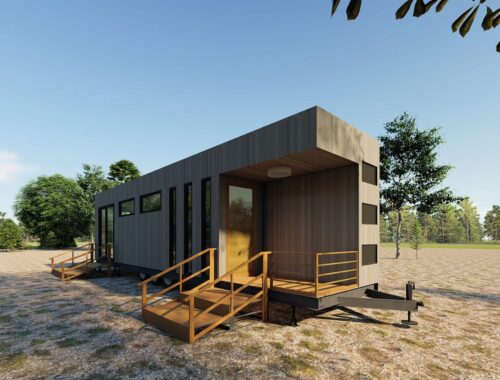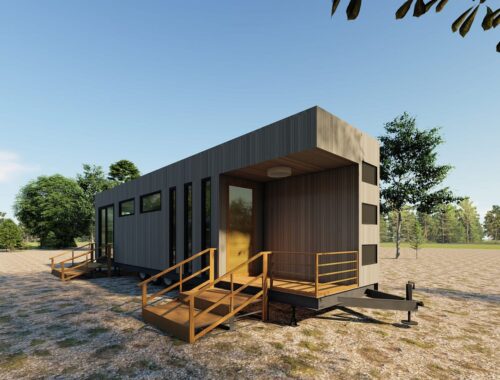Your Sort of Simple Guide to Building an Off-Grid Power System
Distilling our long, tedious road to configuring an Airstream’s solar panels to provide enough energy to allow us to work from the road
Living in our Airstream, Artemis, power has been the number-one challenge. The daily-life stuff is easy to cope with: cooking is all done on propane; we avoid excessive appliances, with pour-over coffee and handheld espresso machines; and off-the-grid lighting falls to Goal Zero’s awesome low-power lights running off their excellent Yeti 400 battery, or to our Luci Lux lanterns.
If you’re used to camping, minimizing electricity use is simple. But we’re not just recreating; we’re working on the road. And the computers, especially Jen’s MacBook Pro and all her drives and photo peripherals, eat through power.
For the last year, we’ve managed with the combination of that Yeti 400 battery and a 100-watt Goal Zero Nomad panel to keep it topped up. It’s a sleek, simple solution that has worked surprisingly well. If we were only out for long weekends, this setup would be ample. However, over a week or two, our reserves dwindle, even when we’re careful with our usage.
We’ve talked about increasing our solar capacity for nearly a year, but the challenges have deterred us. For one, some of the package prices are thousands of dollars, and it’s daunting to take that leap if you don’t know what you need. There’s also the debate between portables panels, like the Nomad—you can move these anywhere to chase the sun but they're more labor intensive and easier to steal—versus built-ins—simpler but mean you can never park in the trees if you hope to harness energy. For us, installation is a quandary, too, as, unlike on a standard RV, piercing the shell of an Airstream isn’t a decision to be made lightly.
It’s the complication, real or perceived, that has made us hesitate. I’m not the handyman type, so when you start talking watts versus volts, DC versus AC power, inverters, wiring, and the like, it feels as obtuse as calculus. Goal Zero has gotten that equation right: their plug-and-play products are simple, and it’s tempting to just grab another panel and a bigger battery, especially now that they’ve launched lithium power stations that offer greater capacity at half the weight and bulk of their current lead-acid battery line-up. But you pay for that convenience—$2,000 for a 1,400-watt lithium battery and $750 per fold-up 100-watt panel, which is what we'd need to cover all our personal and professional needs.
To help decipher the puzzle, I rang up Go Power!, one of the oldest and biggest names in solar for RVs. Mark Spilsbury, the sales manager, said he and his team have gotten very good at discerning clients’ needs in a pretty quick conversation. “It’s just a big math equation. You have to crunch a bunch of numbers,” he says. “We tell people to call us.” That’s tempting. But what I really want is to understand the system and options.
There are two components to any solar setup: the battery-charging system and the AC power supply. The former consists of solar panels, while the latter is an inverter that takes the 12-volt DC power from your batteries and converts it to 120-volt AC power that flows from a standard electrical plug.
Spilsbury likens this setup to a car, where the sun provides the fuel (measured in amp hours), and the batteries are the gas tank. In simplest terms, the more panels you have, the faster the fuel flows into your system. And the bigger the batteries, the more tank capacity for storing that fuel. Meanwhile, the more electricity you use, the faster you deplete the tank. RVs and trailers with big fridges, microwaves, televisions, and other appliances are the equivalent of gas guzzlers.
Like picking the right-size car, configuring a solar system starts with determining how much power you use. For the most accurate numbers, you can get a Clamp-on battery meter and a plug-in electricity usage monitor. But Go Power! makes it even simpler with an online calculator. You still must know the relative draw of your appliances and lighting, which isn’t always as easy as it sounds (it took us some deconstruction and Googling to discern that each light fixture in Artemis draws 0.21 amps, for instance). Once you have the numbers, the Calculator spits out handy usage stats.
In our case, Jen and I apparently average 43.5 amp hours (Ah) a day or 305 Ah in any given week. Artemis came equipped with two Interstate 12-volt Group 24 batteries, for a total capacity of 170 Ah. Remembering that you should never run batteries below half power (85 Ah in our case), that means, without any input into the system, we have approximately two days of usage before our batteries need charging.
The simplest way to lengthen that time is with more battery power, or, to continue the metaphor, a bigger tank. That can mean additional batteries, bigger batteries, or a combination of the two. “If you’re getting free fuel from the sun, you want to have the biggest tank possible that meets your needs,” Spilsbury says. “For full time, I generally recommend six batteries total. At least four.” Upgrading from 12-volt batteries to 6-volts can increase capacity without adding more batteries—making the switch would up our bank to around 240Ah, though doing it is a challenge, as the larger batteries (three inches taller) wouldn’t fit in the box on the tongue. The more batteries you have, the more panels you need to replenish them.
And that brings us full circle: What solar system is right for us?
We crunched the numbers and found out that adding a 100-watt panel to our system would probably give us enough power. Between it and the Nomad, we’d be able to harness some 60 Ah each day. However, given that our battery bank is currently split between the RV batteries and the Goal Zero Yeti, it’s not so straightforward. For simplicity, then, I’m thinking that our optimal scenario is a panel or two on the roof, which would dump straight into the RV batteries. I might even revisit the 6-volt battery upgrade, though it will take some sort of modification to the battery box. Then, we’d use the 100-watt portable Nomad exclusively to top up the Yeti 400 (33 ah capacity), which would run our computing needs.
Go Power! has several options that would work, including the 160-watt Overlander ($704). However, I’m leaning toward the GP-Flex-200 ($1,012), which would put two collectors on the roof, giving us more than enough capacity even if we expand or splurge, with the added benefit of flexible panels that can adhere to Artemis rather than bolt through her shell. We’ll report back in a few months or half a year on what we chose, how the install went, and how the system is meeting our needs.
If you’re thinking about your own system and it still seems complicated, just remember three simple steps:
- Determine how much power you use.
- Choose batteries with enough capacity for those needs.
- Get panels that meet or slightly exceed what you need to replenish.
If you aren’t fortunate enough to have a built-in inverter, as we do, you’ll need to pick an appropriate size one of those, too. “The takeaway is that, really, everybody is going to be different,” says Spilsbury. “But some easy, back-of-the-napkin calculations and estimates will turn up an appropriate system for anyone.”
You May Also Like

ユニットハウスのメリットとデメリットを徹底解説
March 22, 2025
ユニットハウスのメリットとデメリットを徹底解説
March 20, 2025